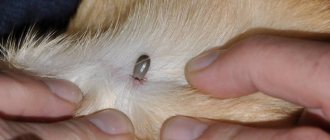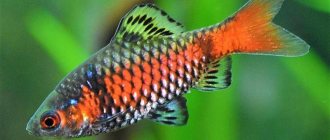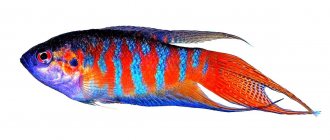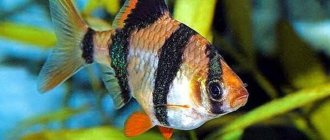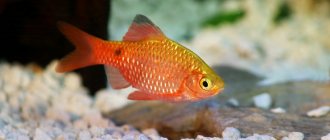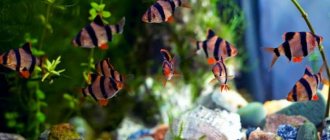SCIENTIFIC CLASSIFICATION:
Kingdom: Animals.
Type: Chordata.
Class: Ray-finned fish.
Family: Cyprinidae.
Genus: Barbs.
Scientific name: Barbus Cuvier et Cloquet, 1816.
The variety of barbs has given aquarists bright and cheerful fish, which have remained top sellers around the world for many decades. Barbs are very active, most of them unpretentious, they reproduce easily and will become a decoration for both species and general aquariums. Multi-colored, shiny, temperamental, interesting barbs have only one drawback - they are too fussy. There are also peaceful barbs, which can be kept with smaller species and not fear for the health of the latter, but the reputation of barbs as aquarium hooligans is fully deserved. Playful and fast, barbs do not tolerate slow veiled neighbors, no matter how big they are.
Habitat of barbs
Distributed in Africa, South and Southeast Asia.
Description of barbs
Most barbs are small schooling fish, measuring 4-6 cm in size. However, there are representatives reaching 35 cm. Small barbs are considered peaceful inhabitants of aquariums, but they can be aggressive to the point that they destroy other fish in the aquarium. In general, these are fast and nimble fish, constantly on the move, they are looking for something and catching up with each other. Suitable for aquarists who prefer active aquarium inhabitants.
BarbosyTOP video review
Description and habitat
Barbs belong to the ray-finned carp fish species that live in many reservoirs. Africa, Europe, South and Southeast Asia are their natural habitat.
The shape of the small body is elongated, spindle-shaped. Females are slightly larger than males, especially during spawning, when their abdomen greatly enlarges. But at the same time, males are much brighter in color.
There are a lot of varieties of Barbus, but most of the body length barely reaches 5-7 cm, although there are also larger species up to 25-35 cm. Many species, like all cyprinids, have small mustaches above the upper lip.
The bodies of these fish are equipped with the Weberian apparatus, an organ that connects the swim bladder with the inner ear. Between their processes there are four bones that form the third rib.
This peculiar internal instrument allows Barbs to hear sound with a frequency of up to 13 kHz, which is a very high level. Thus, ordinary fish perceive only noise levels up to 2.5 kHz.
These underwater inhabitants are omnivores and do not belong to predatory species. The flock prefers to live in dense thickets of aquatic plants. They eat algae, any insects, larvae, and invertebrate forms.
Flocks of Barbs in nature lead a peaceful existence, but defend their territory. These fish are very active and mobile, requiring clean, large volumes of water for movement.
They live for about 5-6 years, but the peak of activity is up to 3-4, then the ability to reproduce in the species decreases. Large varieties live longer - 8-10 years.
Despite their peaceful nature, they are very quarrelsome creatures within the flock, and even in relation to their neighbors, which is why they are often kept in separate tanks in aquariums, which are called barbecues.
Photo gallery of Barbusov:
Types of barbs
Sumatran or Tiger
Wild relatives of this species live in Indonesia, namely on the island of Sumatra. The domesticated species has more saturated colors than its wild relatives. The scales are golden in color. There are four vertical dark stripes on the body. The fins are dark, but have a red or orange edging on the edges. An adult reaches six centimeters.
Sumatran barbs are active and curious fish of medium size. This is the most common type of barb in Russia. Despite its complex character, which is especially acute in uncomfortable conditions or in the absence of a pack. A lone Sumatran will become a real terrorist inside the aquarium. An oblong-shaped tank is suitable for them. You should feed two to three times a day in small portions. This species is distinguished by its endurance and unpretentiousness. It is best to keep a flock of six individuals.
Mutant
For a long time this species was considered a waste, but now these fish are very popular. They are also called mossy barbs.
These are fish up to 7 cm long with greenish-black scales. A distinctive feature is the complete absence of stripes and the light color of the abdomen and gill arches. Boys have small whiskers at the bottom of the jaw, while girls have a more powerful body and a pale color.
Albino
This variety is the result of selection from the Sumatran. Individuals grow up to 7 cm in length. A characteristic feature is a very light color of a creamy or yellowish tint. The edges of the fins have a red edge. There are discolored stripes running down the body.
This type has another name - platinum. If the conditions in the aquarium are favorable, then fish of this breed live up to the age of six.
The fish are quite active and will only feel comfortable in a school of 6 or more individuals. If the platinum barb lives alone, it becomes aggressive and attacks other inhabitants. It is necessary to control the amount of food, because... prone to overeating.
Reproduction is possible only in a separate tank, under the vigilant control of the owner.
Hong Kong
An artificially bred fish breed. Representatives of this species prefer to live in flocks of 5-6 individuals. They are cheerful and not aggressive, but it is better if large fish without long fins live in the aquarium.
Can be kept in tanks with a volume of 50 to 80 liters. Also, fish cannot always stop while eating, and often overeat. To keep barbs alive and healthy, it is worth controlling the amount of food and adding plants to the diet, such as nettles, lettuce and other herbs. Once every 2 weeks, arrange a fasting day for your pets.
An important difference between the Hong Kong barb and the albino is the color of the eyes; in the latter it is always red.
Glofish
In laboratory conditions, glofish fish are injected with a drug containing jellyfish fluorescent.
They don't reproduce.
Platinum Barb
A hardy and not capricious fish, bred by man from Sumatrans. Externally similar to the ancestor, the same body shape and size. Has the same requirements for the habitat. There are no stripes.
Black
The black barb has a red and black contrasting color.
Arulius
This species has an elongated body, light color and dark vertical stripes that run from the back to the abdomen. Males are more intensely colored, smaller in size, and upon reaching sexual maturity they develop white bulges near their mouths.
Meals should be balanced and include protein and herbal supplements. Feeding is carried out in two to three doses per day, and the amount of food should be such that the fish can handle it in 5 minutes. Arulius are unable to control the amount of food they eat and can die from overeating. All food remnants are removed from the reservoir immediately after the meal.
Mr. Tail recommends: variety of species
There are a lot of barbs in the wild, several hundred species, but every year new breeding varieties and breeds appear, more compact and brighter than those living in their natural habitat.
In the aquarium hobby, the number of species used to be about 15, but now there are many more.
Cherry Barbs
Fish of rich, bright, almost burgundy color are widespread in Asia and America. This fish loves the shaded water of streams and slow-moving rivers. Eats diatoms and invertebrates.
These small underwater inhabitants are up to 5 cm in length and always stay in a school.
In a single fish, the color quickly fades. She gets stressed and quickly dies or becomes overly aggressive.
Males are especially bright during spawning; they have a long dark stripe along their lateral line. They are slightly larger than females, but the latter have a larger abdomen. Easily reproduce in home aquariums.
Read more in the article about cherry barbs.
Fire Barbs
They are also called Red or Pink. Large individuals, up to 8-10 cm in length. Very active and mobile. Color pink with red highlights. They have no antennae, the fin plumage is transparent. They live for about 6 years.
There are several subspecies of the Fire Barb, living in Asia and South America.
Sumatran Barbs
One of the most famous and widespread species in the aquarium hobby, which is also called Tiger for its original coloring. Now there are many known breeds bred on its basis.
The species, found back in 1855, is native to Borneo and Sumatra. Lives in clean, air-saturated forest streams and is omnivorous.
It grows up to 7-8 cm and lives for about 7 years.
The fin is high, the head is pointed. The main background of the body is yellow or reddish, it is crossed by four wide black transverse stripes. Ruby and all fins.
The male is smaller and brighter; during spawning, his head also turns red.
During spawning, a female is capable of laying up to 700 eggs. Juveniles grow very quickly and reach sexual maturity already at 2-3 months with a size of 2-3 cm. Very hardy fish with good immunity.
They should only be kept in a flock of 6 or more individuals; individually they become very aggressive.
Barbus Mutants
Or Mossy, selection forms grow up to 7-8 cm, live about 5 years.
It has black plumage with red edging and a bluish, violet, lilac, pinkish tint of the body when rays of light hit it. It was the multicolor color that gave the name to the Mutant breed; because of this feature, the pet’s immunity is significantly reduced.
Shark Barbs
In nature, they live in the reservoirs of Thailand, Cambodia, and Sumatra. They have dimensions of 25-30 cm, silvery scales, large dark eyes and sharp plumage, reminiscent in appearance of shark fins.
Despite their colorless color, the scales have a mirror effect; any other inhabitants of the reservoir appear pale against the background of these pets.
Baloo sharks are large fish, they are very mobile, need a lot of free space, are active, but shy. You need to provide a lot of hiding places for them in the aquarium. They live up to 10 years.
Four-band Barbs
They are quite rare in home aquariums and there are no cases of their sustainable breeding in captivity yet.
Often sold together with the Tiger Sumatran Barb, as they have some similarities in appearance.
The homeland of the species is Asia, Vietnam, Cambodia, Laos, Thailand. The fish is about 4 cm in length. The main background is silver, with four wide stripes of dark color running along the body. The fin plumage is almost completely transparent with a red dot on the back.
Omnivorous and unpretentious schooling fish.
Two Point Barbs
This species naturally lives in water bodies of India and Sri Lanka. Loves small and medium-sized rivulets and streams in mountain tropical forests.
The natural population has declined greatly in recent years due to human activity and the massive catching of fish for sale.
They grow up to 5-6 cm. Males are slimmer and brighter than females. A red stripe of varying degrees of intensity and two dark markings are visible on the silver body.
Cross Barbs
Or Lateristriga, grow up to 12-13 cm and require a large tank to be kept in a flock. A beautiful reddish tint is visible on the green back, the sides are shiny brownish-golden. There are two dark wide stripes along the upper part of the body, and a dark blue line at the bottom, which tapers to a red tail.
This is an Asian species that prefers to live in clean river channels. Sometimes found in the area of peat bogs, due to the high concentration of tannins in the water, the main background of the body is almost brick-like, similar to strongly brewed tea.
A very active and noisy fish that reproduces well in a home aquarium.
Barbus Oligolepsis
They are an endemic species of Sumatra, living exclusively in Lake Menue, the crater of an exploded volcano. The fish are not caught in natural conditions, but are grown on Asian fish farms.
These are miniature barbs, rarely growing up to 4 cm (females). Males are smaller and brighter. Their color is dominated by pinkish and lilac tones, and the high red plumage has a black border.
Barbus Denisoni
It got its name in honor of the colonial governor of India in the 70s of the 19th century, William Thomas Denison.
Endemic to the South Indian Western Ghats mountain range. Lives in the upper reaches of rivers and creeks.
For many years this species was actively caught for sale and is now on the verge of extinction. Exports from India are limited.
The length of an adult individual is 11-12 cm, the slender silver body is crossed out by a black longitudinal stripe with a ruby streak in the upper part of the body. The fin on the back is red, and the tail feathers are transparent, charcoal yellow.
The peaceful fish feels good in a spacious tank in a school of 6-8 individuals. In smaller numbers, pets are shy and hide in algae.
It is very difficult to reproduce in aquariums; only isolated cases are known. Mostly they are bred using hormonal therapy on fish farms in Thailand, Singapore, and Malaysia.
This fish is also called Bloody Eyes and Miss Kerala.
Indian Barbs
They are not always distinguished as an independent species, since some ichthyologists consider them to belong to the Striped Barbs.
Asian and West Indian species (Goa, Kerala, Karnataka). It lives in shallow rivers, covered with leaves and tree branches.
Adults grow up to 7-8 cm. The back is reddish or orange, the belly is light and silver. A wide transverse black stripe runs down the middle of the body. Sometimes there are two or three.
A calm and peaceful fish in a school of 8-10 specimens. It reproduces well in a home tank, does not form clutches, but scatters eggs throughout the soil of the aquarium.
Exclamation Barbs
In the scientific world they are called Dawkinsia exclamatio, named after the Englishman Richard Dawkins. Actually, “exclamatio” means an exclamation mark. It is reminiscent of an individual in an upside-down state (dark streak at the tail and black eye).
An endemic species of Ashtamudi Lake, located in southern India. It is also found in clear mountain rivers flowing into it. In the reservoir itself it lives in coastal silted zones.
The large (up to 10-11 cm) fish has a very provocative and expressive coloring. Perhaps its name is caused by the exclamation at the first glance at this truly multicolored fish. It seems that bright large strokes are scattered in disarray throughout the body. The pattern of each specimen is unique, but there is always a long black streak at the base of the caudal fin.
Males are slightly smaller and brighter than females, and during the mating season, peculiar growths appear on their heads.
A very peaceful schooling beautiful fish. It reproduces well, but many fry die, since the parents do not show any care for the offspring.
Barbus Stolichki
They got their name from the Czech (Moravian in the 19th century) ichthyologist Ferdinand Stolichka, who studied the Indochinese fauna.
Outwardly they are very similar to Barbus Tikto, they are often confused.
The main background is light or dark silver with clear longitudinal markings on the caudal fin and head.
Males have very colorful fins on the back and chest - black and red, the rest and all of the females are transparent and inconspicuous.
They grow up to 5 cm, reproduce well in captivity, and live in flocks.
Odessa Barbs
They got their name not because of their habitat. It’s just that the first aquarium specimen was sold from Odessa only in 2003. And the birthplace of the fish is Myanmar, the Chindwin River with very hard calcareous water.
A strong, dense fish body in reddish-golden tones. An orange wide longitudinal stripe runs from the eye to the tip of the tail on both sides, and the rest of the radiant plumage is yellow and black.
The size of individuals does not exceed 4-5 cm; there are also transverse sparse bluish stripes or dots on the body.
Barbus Arulius
South Indian type of Barbus, in some places almost completely disappeared from the wild.
The powerful wide body (up to 10 cm long) has a pale color in pinkish, lilac, golden tones, it is crossed out by impressive transverse stripes of a dark color. The fins, especially the tail, are red.
Very active schooling fish that reproduce well in captivity.
Barbus Clowns
These Asian underwater inhabitants also have other names - Everett's Barb or White Clown.
This name gave rise to a bright color that really resembles a clown outfit. The large body reaches 10-11 cm when kept in an aquarium; in nature the fish is larger. The body is like a torpedo in shape and speed of movements.
The color is reddish-golden with black sparse transverse stripes, the fin plumage is especially bright - almost orange.
They live for about 8 years. Sexual dimorphism is practically absent. The female reaches sexual maturity by 12 months, the male by 18. If the difference between the partners is more than 2 years, then mating becomes impossible.
Five Striped Barbs
They are endemic to Borneo, this island is located in Malaysia. Most often lives in peat bogs and streams flowing from them.
The fish is small, up to 5 cm, males are more graceful and expressive. The body is painted in red-copper tones with five transverse wide black stripes.
This species has its own variety - the Six-Striped Barb, except for the number of markings, the coloring and body shape of the individuals are identical.
Five-line or Striped Barbs
They differ from the previous variety in that the stripes on the grayish-olive or golden-pinkish body are located not across it, but along it.
This Asian species is large, the fish grow up to 12-13 cm. They reproduce well in captivity.
Green Barbs (Puntius)
A subtropical natural species inhabiting the reservoirs of the south-eastern parts of Asia, which are often also called Chinese Barbs.
They grow up to 7-8 cm, life expectancy is about 7 years.
The body is tall and strong with a bluish-green color with a metallic sheen, the plumage is reddish along the edges. There are no characteristic transverse stripes.
When the fish reaches 2-3 cm in length, it is ready to mate. The male's head turns red.
Schubert Barbs or Golden Barbs
This is a completely selective species obtained by crossing Green Puntius or Barbus. The breed was registered by the American breeder Thomas Schubert.
It is essentially a golden (yellow) mutation of the Green species. The background of the elongated spindle-shaped body (up to 8-9 cm) can be golden-lemon, straw to light orange shades. The fin plumage has a reddish tint, not too frequent dark markings of varying sizes are scattered across the scales, each plate has a coal edge. Large eyes and short whiskers complement the appearance of this pet, which lives in the aquarium for about 3-4 years. The immunity of the mutating species is somewhat reduced.
Females and males are almost impossible to distinguish. Males during the spawning period look a little slimmer and brighter.
Barbs Butterflies
Or Moths - an African species that inhabits the right tributary of the Congo, the Mongala.
These are small fish (up to 3 cm) of pinkish-silver color with yellow plumage. There are several sparse and large black markings on the body.
Males and females are practically indistinguishable in appearance.
In nature they breed twice a year during the rainy season. The same breeding pattern is maintained in home aquarium keeping.
Albino Barbs
Also artificially bred on the basis of the Tiger Sumatran Barb.
The body is light in color - from pale lemon to light peach. This breed is often called Platinum or Golden Tiger Barbs.
Pets grow up to 7-8 cm and live in the aquarium for 6-7 years.
During the mating season, females become heavier due to their expanding abdomen, and males are brighter and have red spots on their heads. With a growth of 3 cm, the fish are already ready to mate.
Sunny Barbs
They are often called Golden Dwarfs for their small size (rarely growing up to 4 cm) and golden body color with rare wide black strokes at the base of the entire fin plumage.
The fish’s homeland is the Ganges River; now, in addition to India, it is also found in Bangladesh and Nepal.
These are extremely timid pets that, without a flock of 8-10 individuals, will simply die from stress. They reproduce well at home.
Red-tailed Barbs
This is a large Asian species (Mekong, Chao Phraya, Mun rivers).
In an aquarium they can reach sizes of 20 cm; in their natural habitat, individuals are larger. Life expectancy is about 10 years.
Has a very high back. The body is painted in silver or golden tones, and the plumage and especially the caudal fin are red.
To keep them at home, you will need a large aquarium, since a flock is required; individual individuals are very stressed.
Reproduction in captivity is almost never successful. Pet stores sell fry raised on Asian fish farms.
Cuminga barbs
They are an endemic species of Sri Lanka, living in only two rivers, Kepani and Kalu. The first is inhabited by a fish with red plumage, the second with golden ribs. The underwater inhabitants of their native habitat are becoming more and more inconspicuous every year. Massive harvesting for sale, massive deforestation and pollution of water bodies have caused irreparable harm to the Kuminga population.
Males are smaller and much more expressive than females. But their sizes rarely reach 5-6 cm.
The redfin variety is very rare and highly prized.
Both subspecies have dark markings on the gill covers.
Diamond Barbs
A medium-sized Asian type, endemic to Borneo, inhabitant of peat bogs and streams flowing from them.
They reach 5 cm in length, have a pinkish-golden iridescent body with 3-4 strokes of a dark diamond-shaped color.
They are most beautiful in dim lighting; in bright light they become pale and silvery.
Tikto barbs (scarlet)
Widely distributed in Hindustan - India, Pakistan, Nepal, Bangladesh, Bhutan, Sri Lanka. They love small streams and rivulets with a silted bottom covered with fallen leaves.
Adult specimens reach 6 cm in length. The main background of the body is orange-red or pink.
There are usually two large markings on the scales - near the gills and at the base of the caudal fin.
Read more in the article about scarlet barbs.
Barbus filamentosa
An Indian variety found primarily in Kerala. Selects swampy areas in the floodplains of small rivers.
Large individuals grow up to 12-13 cm and require a large tank of at least 400 liters for a flock of 4-6 individuals. Very mobile and active.
The body is silver with a pinkish tint and a large black marker located closer to the base of the tail. The fins on the back are strongly raised and clearly defined, resembling feathers or threads.
Black Barbs
Or Purpleheads are an endemic species of Sri Lanka, found in clear forest streams. The natural population is in severe decline, as less than 5% of the tropical jungle remains on the island.
A very beautiful and bright fish, in great demand among aquarists. Massively produced in Asian fish farms.
The strong, laterally flattened body is colored blue-pink, lilac, violet and crossed out by wide black transverse stripes. They grow up to 6-7 cm, males are more graceful and brighter than females.
During the mating season, males acquire a purple head color, and the scales on the body become almost charcoal, since each plate is equipped with a black edging. The females do not resemble them at all - they are pale yellow.
Stiff-lipped Barbs
Asian large fish (up to 30-35 cm), included in the list of commercial fish in some countries. They live in small rivers of Thailand, Laos, Cambodia, Vietnam, Borneo, Sumatra, Java.
A strong, powerful, elongated body of a silver color, but on each scale there is a dark dot, so the fish appears to be covered with horizontal stripes. High plumage with a pinkish tint.
It has several subspecies, slightly different in color tones.
Sexual dimorphism is practically absent. It is impossible to distinguish between female and male individuals.
They are very voracious, with their large strong lips they scour the entire bottom in search of food, even eating algae.
A single fish will be highly stressed, so the aquarium of these shy giants should contain at least 5 individuals, and its volume should be at least 600 liters.
It is almost impossible to obtain offspring at home. For commercial purposes, Stiff-Lipped Barbs are bred on farms in Thailand, Vietnam, Singapore, and Malaysia.
Dawkins Barbs
These fish are also called shaded fish. The species was discovered by English biologist Richard Dawkins, who was exploring Indian biotopes.
There are several subspecies that live in clear mountain streams with a rocky bottom and oxygenated water, and inhabitants of lowland rivers in which muddy water flows very slowly.
A very beautiful fish, growing up to 10-12 cm and intricately colored. It seems to consist of two parts - the upper one is very bright, golden with a scarlet dorsal fin. The semicircular border in the middle of the body is marked with a red dotted line; there is the same edging on the scales. But the lower part of the body is white with a slight pinkish tint. There is a large dark mark near the base of the caudal fin and a blue neon smear on the gill slit.
The tips of the two-lobed large caudal fin in males have bright red and black markers.
Keeping in an aquarium
Barbs belong to the carp family; their body shape has a classic appearance: a laterally flat oval body with a pointed muzzle and a mouth in the middle. There are two pairs of antennae around the mouth. In some species they are noticeable, in others they are practically invisible. Barbs have well-designed fins - spinal, anal, caudal. The tail is forked, two-lobed. Size, color, character depend on the species. Sexual differences are expressed in the brightness of the color and the shape of the abdomen.
Motherland
The Sumatran barb (Puntigrus tetrazona) is a representative of the carp family, which became an inhabitant of aquariums more than 100 years ago, and its popularity still does not fade. They were first described by ichthyologists in 1855.
The very name of the fish reveals its habitat. Initially, this species was endemic to the islands of Sumatra and Borneo, but over time it spread to the waters of Thailand, Cambodia and Singapore. Now you can even find local colonies of these fish in natural reservoirs in Australia, Colombia and the USA.
In natural conditions, barbs prefer forest streams and tributaries flowing through the jungle. They have a sandy bottom, clean and oxygen-rich water, many plants grow, in other words, there is everything for food and shelter.
Imitate natural habitat conditions for your fish.
Living in natural conditions, barbs do not have such bright colors as aquarium barbs obtained as a result of long breeding experiments. This is how the golden (albino form), mossy, veiled barb and a genetically modified form of Glo fish with a bright fluorescent color of red and yellow-green were bred. To obtain such transgenic specimens, fluorescent protein genes of sea inhabitants were introduced into the classical form.
The body of barbs is strong and laterally flattened, the fins are triangular, and there are no whiskers. Aquarium specimens grow up to 6 cm in length. A characteristic feature of the color of these fish are four dark transverse stripes running through the entire body. In captivity, their life expectancy is up to 6 years.
Setting up an aquarium
- The volume of the aquarium depends on the size of the fish. It is better to plant barbs together that are suitable for each other in size. The average volume for Sumatrans, mutants and the like is 50 liters per flock of 3-4 pieces. Ideal conditions are 80-100 l, and the number of fish is at least 6-7.
- The shape of the aquarium is preferably such that there is space for swimming. For small fish, picture aquariums are suitable, the peculiarity of which is a small thickness with a large height and length.
- Since barbs are mostly active and jumping fish, the aquarium needs a lid!
- The lighting is moderate, but thoughtful: some varieties of barbs look more advantageous in the light of a good lamp.
- Filtration and aeration are standard; the filter and compressor are selected to suit the size of the aquarium. If you have living plants, you can create conditions for their active growth.
Water parameters
- Temperature – depends on the variety. The average range is 22-25°C. Sumatrans like temperatures of 20-24°C. Others may require warmer water.
- Hardness 4-20. This parameter does not play a significant role for most varieties.
- Acidity 7-8.
- Water changes should be regular: for Sumatran barbs this is a weekly procedure, for some lovers of quiet swampy reservoirs it can be changed once every two weeks. You need to change one fifth. Combine with soil cleaning.
Plants and soil
- Barbs don’t mind digging a little, so it’s better to fill the bottom with fine sand or river pebbles with a fraction of up to 4 mm. However, these fish do not have great demands on the soil.
- We need live plants. Plant them so that they leave free space for swimming. Most barbs love to eat foliage and will eat anything that grows in the aquarium. Therefore, to maintain a barbecue plant, you need to choose strong plants or fast-growing ones.
How long do barbs live?
At home, barbs can live 3–5 years. Larger species, if cared for, can live up to 10 years, then they are kept alone or in pairs. But caring for larger species is more difficult. Barbs can be bred as soon as they reach 5-9 months, after which they are ready to breed.
Aquarium Basics
Barbs are relatively unpretentious pets, for the maintenance of which the following rules must be followed:
- Choose a tank with a volume sufficient to support a flock of 6-10 individuals. Depending on the type of fish, it can be different; for dwarf species, 100 liters is enough; for large ones, sometimes 600 liters and even 1000 liters are needed.
- Temperature range +20…+25 °С.
- Other indicators of the aquatic environment are not so important, although in nature Barbs prefer slightly acidic (6.0-7.5 pH) and soft (up to a maximum of 10 dH) water for the most part. It can be softened by osmosis or passing through a peat filter. Only Barbus Odessa lives in calcareous reservoirs with a high carbon number.
- It is better to choose plants that are floating or have a strong root system. Some Barbs like to dig.
- Shelters are needed not only from aquatic plants, but also from driftwood, stones, and artificial decorations.
- Fish look better against a dark background. It can be used as non-chemically colored pebbles, basalt or gravel with a fraction size of 3-7 mm.
- The tank should be designed in such a way that there is enough space for the flock to move freely - Barbs are very active and mobile.
- Fish in natural habitats live in flowing waters, so weak currents should be simulated using aeration and filtration devices.
- At least one fifth of the water volume must be replaced weekly with clean, settled water.
- Almost all varieties prefer dim lighting.
- It is better to cover the artificial pond with a lid in order to prevent restless Barbs from jumping out and splashing water.
Care and maintenance of barbs
Barbs feel good at fairly low temperatures of 20-24. The composition of the water does not play a significant role; these fish are accustomed to living in running water. Therefore, it is advisable to create a current in the aquarium using filtration. Small species are kept in a flock of 5-7 pieces. Their lifespan in an aquarium is usually ~3-4 years. Large fish, for example, the shark barb, are often kept singly or in pairs.
It is advisable to use dark soil color for barb fish; in this case, the fish will look brighter. Planting should be loose, with space for floating, because It is in open areas that fish show their active character. The presence of floating plants is optimal for them. There should also be separate densely planted grass areas that serve as shelter.
When keeping barbs, you need to take into account the characteristics of a particular species; sometimes the variety of different species confuses novice aquarists. In general, most species can be kept in aquariums of 50-100 liters.
It is not worth keeping barbs with sedentary neighbors, because... they will constantly create a stressful situation. Large barbs can compete even with aggressive aquarium inhabitants.
The most important thing is that there are no excessive concentrations of nitrogen compounds and phosphates . Every conscientious aquarist should always have a set of drop tests on hand, at least for nitrate and phosphate. Fortunately, they have now become inexpensive, there are no problems with their assortment and acquisition. For example, we can with a clear conscience recommend you the cool UHE drop tests, , but they are sold only online. In stores in your city - offline, you can find inexpensive Vladox tests .
When changing water, it would be a good idea to use clean water supply and use drugs that block harmful substances. For example, Tetra AquaSafe - it blocks chlorine compounds, heavy metals + contains B vitamins, iodine and other aquarium goodies.
Barbs are omnivorous fish. In biotopes they eat everything that Poseidon sends: insects, larvae, worms, algae, plants. In aquarium conditions they eat dry food perfectly. The basic food that can be recommended for them is TetraMin.
However, if you keep barbs in a herbalist, it is advisable to additionally feed the fish with food containing plant ingredients, for example, the same Tetra Phyll. This manipulation will diversify the diet and protect your plants from the close attention of watchdogs.
It should also be noted that when purchasing any dry food, you should pay attention to the date of its manufacture and shelf life, try not to buy food in bulk, and also store the food in a closed state - this will help to avoid the development of pathogenic flora in it.
Compatibility
Barbs are generally a peaceful fish with the right choice of neighbors and a well-established hierarchy in the school. In this case, they will be busy only with their relationships, not paying attention to other underwater inhabitants.
You should not add too small and slow pets to them; you should choose proportionate and equally active ones who can stand up for themselves.
The following are good neighbors for Barbs:
- clown battles;
- gourami;
- large tetras;
- platies;
- zebrafish;
- swordtails;
- cichlazomas.
You should not add them to active Barbs:
- minors;
- analysis;
- Corydoras catfish;
- thornetium;
- cichlids;
- telescopes;
- mollies;
- discus;
- angelfish;
- guppy;
- neon;
- shrimp.
But it should be remembered that depending on the variety of Barbus, there are various restrictions on compatibility and this issue should be clarified every time you purchase fish from a breeder or in an aquasalon.
The best solution from the point of view of the safety of all underwater inhabitants would be to create a barbecue tank, a monospecies aquarium.
And if, nevertheless, a decision is made to form a common artificial reservoir, then juveniles should be purchased. She does not yet know how to show aggression and can grow up on friendly terms with her neighbors.
Reviews of barbs
Olga Kazakovskaya, review of the scarlet barb (Odessa)
A beautiful, nimble fish with a wonderful appetite. Peaceful and unpretentious. It is better to keep them in a flock. You can’t go into an aquarium with expensive plants, because... eats young shoots.
Maria, review of the fiery barb
Excellent and impressive guys. They haven't eaten a single plant from us. They are able to repel intrusive Sumatrans. They themselves are very good-natured and don’t bother anyone. They have been living with us for 4 years already, we took two of them for testing, both males, they live and know no troubles, although I was sure that the Sumatrans would kill them and would be stressed without a flock. An excellent fish for beginners.
Artemiy, review of Denison's barb
A very beautiful schooling fish, not fussy in a large aqua with greenery. Very playful. It's interesting to watch them. And peaceful. Resistant to diseases.
Feeding
Barbs are omnivorous and absolutely unpretentious in their choice of food. They can be given any live (bloodworms, daphnia, tubifex, cyclops, Artemia nauplii and others) and frozen food.
Dry granulated factory formulations, which also contain plant components, are well suited. Otherwise, aquatic plants will be eaten.
These fish are voracious, they eat both from the surface and look for leftover food in the ground. You should feed them twice a day, but in small portions so as not to clog the pond.
Breeding
Sexual differences in Barbus varieties manifest themselves differently, in some they are almost invisible, in some species the male is larger. But for the most part, the male individual is more graceful, slender and brighter, while the female is paler and more massive due to her rounded abdomen.
Some Barbs reach sexual maturity at 2-3 months, others only at 1.5-2 years. It all depends on the specific breed.
Those types of Barbus that are capable of breeding in captivity are most often unpretentious during the spawning process. The pair can be placed in a separate tank, and in the barb cage mating will also occur in the flock.
In the spawning tank, the temperature is increased by a couple of degrees and daily changes of soft water are made. A couple are planted in the evening, and in the morning, more often than not, the entire bottom, on which it is better to place plants rather than soil, will be strewn with eggs.
Barbs are careless parents who eat their offspring, so they must be removed immediately.
The fry begin to peck within a day or two. They do not immediately emerge from the algae; they feed on the yolk sac for two or three days.
As soon as the juveniles swim, complementary foods should be introduced. For the first, live dust is suitable, then ciliates and rotifers, Artemia nauplii are added.
The fry grow quite quickly and should be regularly sorted by size to prevent fighting and cannibalism.
Reproduction
Now barbs are not caught from natural bodies of water. All fish that are on sale were bred on fish farms in one of the countries in Southeast Asia or by local breeders. Although barbs are spawning fish that do not have parental instinct, even a novice aquarist can cope with their reproduction.
Sumatran barbs are bred in captivity as follows:
- First, manufacturers are selected. Individuals aged 6-10 months that have reached sexual maturity are suitable for spawning. It is noteworthy that until this moment it is very difficult to distinguish a female from a male. Females are larger with a dense abdomen, and males are brighter in color, their fins are intensely red.
- Before spawning begins, the spawners are caught from a common aquarium and kept separately for some time on a diet of live low-fat food and herbal supplements. The water temperature when kept separately should be within 22-24°C.
- Next, you need to prepare a spawning tank - an aquarium with a volume of about 10 liters. Instead of soil, synthetic fibers or Java moss are laid on its bottom. It is also necessary to lay a separator net so that the parents do not eat their own caviar. For the same reason, there should be no snails in the spawning area.
- Water from the general pool is poured into the aquarium, it is heated to a temperature of 25-28 ° C and the producers are started. During spawning, the fish are not fed, and after the female barb lays (up to 1000) eggs, the parents are returned to the general aquarium.
- After this, 1/3 of the water must be replaced with fresh water and tinted with methylene blue. This will help prevent fungus from appearing on the eggs. Fertilized eggs will develop in 1-2 days, and after 3-4 the fry will swim and feed on tiny organisms or “living dust” (for example, ciliates). Food for babies must be prepared or purchased in advance, because the fry are very voracious, they should be fed at least 5 times a day.
Barbus fry at the age of 7 days.
After just one month, the juveniles will become indistinguishable in color from the adults. When they reach a size of 1 cm, the fry can eat all types of dry and live food. After this, their color begins to change, and caring for the fry becomes easier.
Once or twice a year it is recommended to stimulate spawning in a general aquarium. This will prevent the formation of cysts in females.
Sex differences
It is very difficult to distinguish between a male and a female before the onset of sexual maturity. Females have a larger belly and are noticeably rounder.
Males are more brightly colored, smaller in size and have a redder muzzle during spawning.
Diseases and prevention
Natural species of Barbus for the most part have high vitality. Immunity is somewhat reduced in breeding species with a mutated genotype.
For the most part, the pathologies of these aquarium pets include diseases associated with violation of conditions of detention and care:
- Problems with the gastrointestinal tract. They come from gluttony and overeating, which in turn leads to obesity, decreased immunity, and the inability to reproduce. Ichthyologists have found that Barbus has enough food per day, amounting to about 3% of its weight. It’s good to do a fasting day once a week if your pets are kept in a barber barn.
- Diseases of the genital area. In females, inflammation and ovarian cysts sometimes occur. The reasons are most often a violation of spawning conditions. Only an ichthyologist can help here.
- Dermatomycoses. This is the scourge of all tropical fish. Parasites appear in a tank with poor-quality food, when quarantine is violated, due to a decrease in the level of hygiene of the aquarium. Infections such as fin and gill rot, ichthyophthoriosis (semolina) occur. For treatment, Malachite green, Bicillin-5, Biomitsin, Rivanol are added to the water.
Who do barbs get along with?
Even large fish of this breed cannot be called aggressors. Of course, misunderstandings can arise within the “family” of barbs, and there are situations when these peace-loving inhabitants react sharply to their neighbors. However, if you choose the right inhabitants, such troubles can be avoided.
When in a bad mood, the barb can “ruffle” the luxurious fins and tails of other inhabitants. And while smaller, more nimble guppies and bettas can escape from an angry neighbor, slower veiltails, telescopes and angelfish can be seriously harmed. Not the best company is made from active, mischievous “mustache” and cowardly, inert lalius. And you shouldn’t expect peace with the brawling astronotuses - in this case, competition will definitely arise.
Of course, it is best to have a flock or several barbs - they are more impressed by such conditions. But if these fish are supposed to be kept in a common tank, you can place them with platies, parrots or mollies. They have a similar character and lifestyle, so they can coexist in the same territory without any problems.




